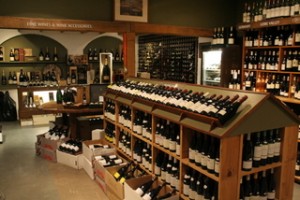Caviste revisited

Inside Caviste, Overton
Wine shop Caviste changed hands earlier this year, and its new managing director is Ben Llewelyn, invited me to their Overton shop for a tasting.
The shops are owned by wholesale and importing company Carte Blanche Wines, which supplies about a third of the Caviste wine list. Llewelyn said CBW’s search for “growers who can wrestle a vine properly” ensures the producers they represent feel like friends. The majority of these friends come from the old world.
New ownership means that the range has changed quite dramatically, said Llewelyn, with “over 1,400 lines in the shop, there was a lot of noise that customers were not able to hear through. We’ve thinned out the range, focusing on a price/quality ratio” that has seen a core range of around 300 wines be put in place amid a total range of around 800 wines. Of the wines I tasted, see below for notes, the Domaine de la Graveirette, Cotes du Rhone 2009, at £11.95 had the best price/quality ratio.
Tastings are an important part of the new business. Llewelyn said “we try to do a tasting a month, for example a ‘tasting and tapas’ or a tasting and discussion masterclass” such as the recent one on northern Rhône wines.
Wine tasting, October 2011
A selection put together by Llewelyn “of the wines I like drinking at the moment.”
Kenton Vineyard, Estate White 2010, Devon, England £8.50
11.5%. Made from a blend of ortega, solaris, auxerrois, seyval blanc.
Enticing white peach and elderflower aromatics. Very clean, fresh and lightly balanced, right on the cusp of tasting off dry, in that fresh, perky line. And decent value for English wine of this calibre.
Domaine d’Uby, Domus 2010, Côtes de Gascogne IGP, France £7.95
11.5%. Blend of colombard and sauvignon blanc.
Muted nose, but palate is fresh, citrus with elderflower and pink grapefruit in abundance. The wine has good volume and density of fruit. Llewelyn said this should be much more intensely aromatic, but we ran out of time to taste another bottle which he had chilling down. The balance and fruit concentration was fine, and it had all the zinginess and zestiness and pithiness that a good Côtes de Gascogne blanc should have.
Patrick Piuze, Petit Chablis, Cuvé Spéciale Juliette Anais, 2010, France £13.50,
Patrick used to work for Jean-Marc Brocard. This wine is named after his two daughters.
12.5%. Oatmeal and hazelnut cream. Palate has a rich, savoury-fresh edge, with big mealy flavour, much more than your average Petit Chablis. This is in a, pithy, full-fat, obvious and immediate style, which is immediately appealing for that.
Domaine Cheveau, Sur Le Mont 2010, Macon Solutre-Pouilly, France £13.95
13.5%. Citrus, pithy, steely, nose, on a tight, fresh and vibrant, alive wine. White peach and nectarine in a zingy citrus core. Lots of long, linear flavour, with elegant intensity, in a delicious, lengthy wine. Jolly nice.
Tierra Agricola La Bastida, Rioja blanco 2010, Spain, £12.95
13%. Six months in oak. 60% viura, 30% malvasia, 10% garnacha blanca.
Aromatic new oak vanilla and broom is the first smell, and it’s not too dominant. The palate is fresh with citrus and tropical fruit, but I find the faintest oily note at the end which detracts a little for me.
Bodegas Forjas del Salnés, Leirana Albarino 2010, Rias Baixas, Spain, £17.95
12.5%. Peach and peach skin, peach blossom fragrance, full, lush-fresh combo. Real intensity of flavour, tropical, guava-ish and mango, huge intensity, massively concentrated and still quite tight with its acid core. Kernel hints on the back palate add flavour and deliciousness. Lovely, with long finish.
Castell d’Encus, Taleia 2009, Costers del Segre, Spain, £27.00
13.5%. Blend of sauvignon blanc and semillon, part fermented in new French barriques (though you’d never know to taste). Grown 1,000m up in the Pyrenees.
Muted nose, then creamy, fresh, tight palate, almost sour (in a rounded, positive and appealing way), pithy and with concentrated citrus, peachy fruit in a long, linear, enthralling fashion. Slight delayed reaction sort of appreciation as the palate catches up with what it’s tasting. Long. Vg.
Az Agr. Buglioni, Valpolicella Classico 2010, Italy, £10.95
60% corvina, 25% corvinone, 10% rondinella, 5% molinara
Medium pale cherry colour, with bright red cherries on the nose, a smooth, fresh crunchy texture. Good density of spiced cherry fruits. Nicely balanced, with crunchiness and decent concentration. Hugely drinkable wine; very nice.
Bodegas Forjas del Salnés, Tintos de Mar, Bastion de la Luna 2009, Rias Baixas, Spain, £17.95
My very first red wine from Rias Baixas. A blend of espadeiro, loureiro and caiño, fermented separately then blended later. Fresh, bright red cherry nose, with liquorice and tar aromatics. Has a firm core, with a tarry spikiness, and dark herbal, leafy notes. Quite a challenging, individual wine.
Manoir du Carra, Julienas 2010, Beaujolais, France, £13.95
13%. Crunchy red cherries and violets on the nose, with flavours of sweet cherry tunes and succulent primary fruit, intriguingly with attractive ginger and juniper spiciness, unusually for reds. Has a good freshness and liveliness about it.
Domaine de la Graveirette, Cotes du Rhone 2009, France, £11.95
14.5%. 50% syrah; 50% grenache. Fruity, with hints of meaty notes – biltong and steak-with-ketchup – and an enticing hint of liquorice. Fresh and perfumed attack, with silky smooth texture and real freshness of density. Much more complexity than a many a Côtes du Rhône normally achieves. This is really quite serious and tasty, with a lengthy finish. Good value.
Bodegas Ayles, Garnacha 2010, Carinena, Spain, £8.95
14%. Red berry fruits in a sweet-fruited wine, which is altogether a bit too simple and simply juicy at this price.
Tierra Agricola La Bastida, Tempranillo 2007, Rioja Crianza, Spain, £14.95
14%. 12 months in American oak. Rich, classic, coconut nose, followed by equally classic medium weighted wine. Then it erupts into bright, youthful, red berry fruits, in an immediately appealing wine, without any hindrances of complexity that might require intellectual input, which is no bad thing on occasion.



